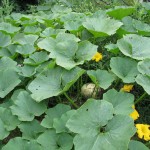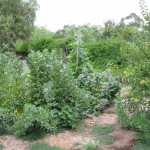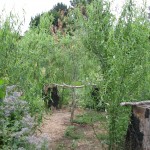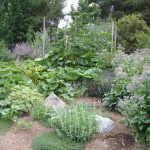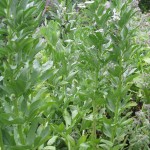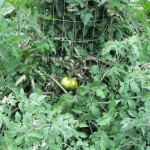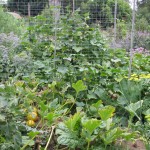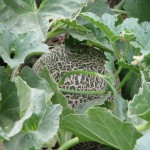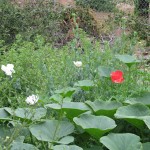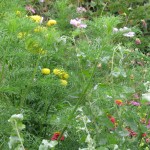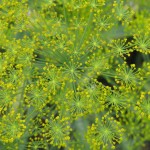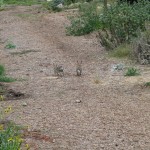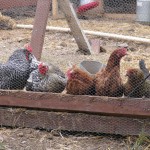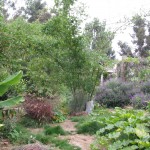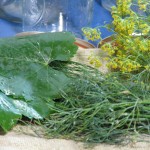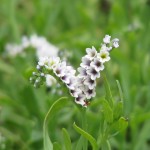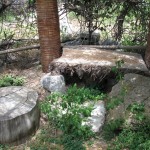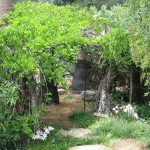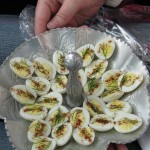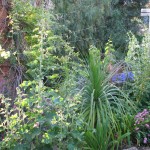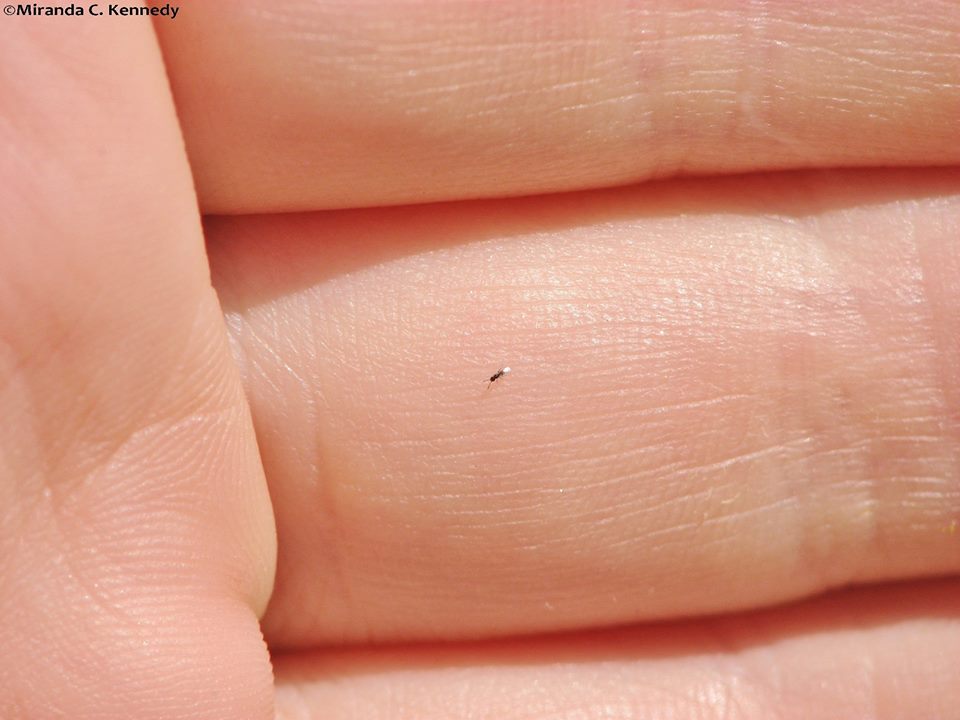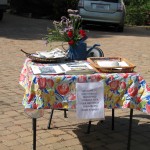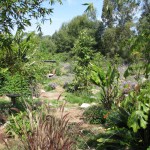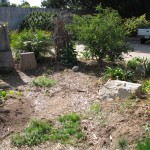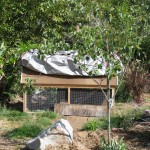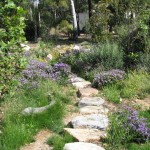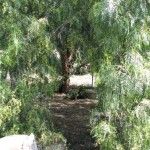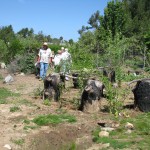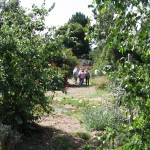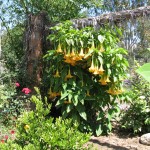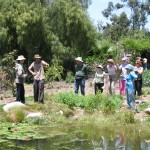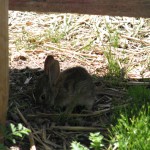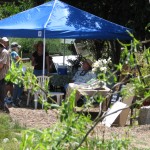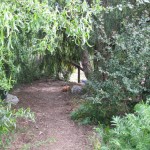Animals
- Animals, Chickens, Gardening adventures, Heirloom Plants, Herbs, Other Insects, Permaculture and Edible Forest Gardening Adventures, Photos, Ponds, Quail, Vegetables
What’s Happening in the July Garden
A banana squash stealthily growing huge An apricot tree with fava beans, squash, herbs, artichokes, and tomatoes The withy hide growing beautifully Kabocha and delicata squash on the ground, zucchino rampicante on the trellis, Christmas beans, favas, Swiss chard and medicinal plants around a small avocado tree Favas: great for the soil, great for the dinnerplate Heirloom tomatoes. Why do they all come ripe at the same time? Sugar pumpkins are ripe already in the Mediterranean guild. Also figs, paste tomato, dill, fennel, thyme, pickling cucumbers and artichoke. Plant guilds of squash, beans, flowers, etc. are flourishing. Heirloom green melons hiding from the hot sun. By now the wild buckwheat has dried up, which starves the bees. But not here. Matilija and Flanders poppies over banana squash Monarchs are so plentiful this year that we have to take pains to avoid them. Wildflowers host an incredible diversity of insects Dill flowers looking like a spectacular firework In a balanced wildlife habitat, bunnys do little harm All five girls waiting for treats in the Fowl Fortress Pumpkins, bananas, bamboo and much more by fescue paths. Fresh grape leaves, dill and garlic from the garden for the pickles Hot weather? Must be canning season! Pickled cucumbers, zucchino and onions, and peach pit and peel jelly. Very large yellow waterlilies Native salt heliotrope by the big pond. Volunteer tomato in the shade of the Nest, by palm tree bench. Wisteria, grapes and zerpheranthum lilies around the Nest Blooming banana Quail eggs! Double heirloom hollyhock Egyptian lilies Fourth of July rose celebrating the holiday -
Chicken Rescue
I know its been a long time since I’ve posted. Sorry! Its not that I haven’t been taking lots of photos and planning posts in my head. Its just that there has been no time (especially since loading photos on WordPress takes so long and it does such inexplicable things, it is sometimes three hours to make a post come out correctly!). It has been harvest time. Thank goodness I have help in the form of my collegiate daughter, home for the summer. Peaches, plums, strawberries, a few blackberries, four apricots (stupid trees!), cucumbers and of course, zucchini and tomatoes. I’ll post on some interesting heirloom varieties we’ve been growing at a later date.
We’ve also been trying to avoid the hot and humid afternoon weather and of course participating in all the volunteer work I’ve let myself in for. It is all good and worthwhile, but really, the days need to be longer! Keeping the garden pruned back, staked, vegetables harvested, and taking care of our animals have taken up the days as well. I wake about 6 or earlier and begin the feeding procedures. We have two elderly dogs, one who needed medical attention last week, both of whom are on meds. We also have a sick cat who is on meds, needs to be coaxed into eating (same with the dogs), needs subcutaneous fluids (feline water balloon!), and now has a drain on her head along with a plastic collar. Fun, fun, fun! By the time my daughter and I get to our own dinner, it is about nine p.m. and I don’t even have time to read! Now THAT is busy!
Then yesterday morning I rose early and used the string trimmer for three and a half hours, some of it near the Fowl Fortress. At the end of the hot and humid day, our partially blind hen Madge was perched on top of the Rubbermaid container in which their food is kept, but she was hunched over with her wings a little out. Not a good sign. Probably egg binding brought on by stress from the noise of the weed whipping and the heat. Egg binding can be fatal; we lost a hen to it before we knew anything about the problem, successfully saved the lives of three more hens who had it last year although Lark remained eggless to this day and just gains weight instead.
Immediately we brought her up to the house, filled the kitchen sink with warm water, and put her in. Madge is a Rhode Island Red, a rather large chicken, and to submerge her ‘vent’ I had to hold her wings with both hands and press her farther into the water by laying across her. I also massaged her undersides gently; we had to be very gentle so as not to break the egg inside of her which would be very bad.

No, not just another hard night for Mom. My daughter was kind enough to fold up a dishcloth and put it under my forehead to stop the edge of the sink from hurting my head.

But wait.. what is that? Madge is a sweetheart of a chicken. She is truly grateful for having been rescued and doesn’t mind being picked up.

It looks like a little face…. She was very patient with all of this. Since it was warm and soothing, near bedtime, and because my daughter was singing Nat King Cole tunes softly as she worked in the kitchen, Madge dozed off a little during the 15 minutes we soaked.

“Hello.” We could have gone another five, but the water was cooling and my back was telling me that the chicken dunking was over.
My daughter took the wet hen upstairs to the only room which doesn’t have an animal in it, and which held the warmth of the day, and gently dried her. The now relaxed Madge worked her vent a little, then out came one of her huge eggs right on the towel in Miranda’s lap!

Egg success. The egg was very rough textured with calcium deposits and must have been very painful to lay.

Rough shell with calcium irregularities. Ouch! Madge’s eggs are always very large anyway.

Madge’s egg next to Amelia’s She was a much happier chicken, and I knew we’d saved her life. She had a calm night in a pen in the warm room and this morning I heard the melodic croons of a waking hen.
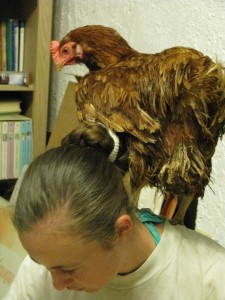
A wet but relieved Madge deciding to roost on Miranda. Bedtime! Since she laid yesterday morning’s egg in the evening, the next egg had already been forming for today. She laid it, and although the shell was hard you can see the malformation on the shell as it formed next to the other egg. Poor sweet baby!

Malformed egg next to regular egg For the moment, the cats, dogs, tortoise, hens and quail are eating, taking meds and recovering. Next on my list for the afternoon? Clean the 90 gallon fishtank and the hummingbird feeders! That small cave on a remote island sounds mighty good sometimes. Of course, I’d probably end up feeding the bats.
-
Fowl Fortress
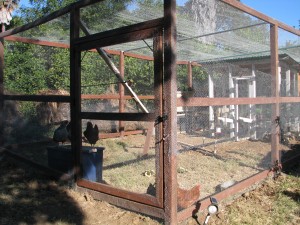
Front of Fowl Fortress I wanted to protect my hens from rats, snakes, weasels, raccoons, hawks and possible nuclear destruction, so I had the Fowl Fortress built. I was going to try to do it myself (ever taunting the gods of construction with my ineptness in this field). I bought Redicrete, t-posts and aviary wire. Then I came to my senses. I’m having shoulder and back problems, I wanted the coop to be done by the time I left to pick up my daughter from Oregon last week, and I really didn’t want the coop to be an eyesore.
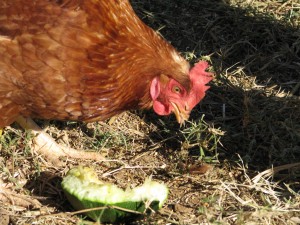
Partially blind Madge enjoying zucchini And I only wanted the best for my girls!
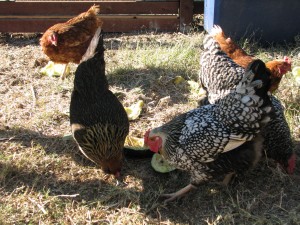
L-R: Viola, Chickpea, Miss Amelia, Lark and Madge So I hired the contractor who put up my wooden fence a few years ago. He said he’d do it over the weekend. Of course, not only didn’t it get done until 7 pm the night before I left the state, but he’d run over a whole lot of plants with his trailer, broke an irrigation line and a small tree, was scooping buckets of pond water to use for the cement because he didn’t see the HOSE and HOSE BIB that was right there (I found two buckets left over the weekend, and they had live mosquito fish and a pond snail in them! Ummm… habitat area! No-kill zone! Gee!). Frustration mounted and didn’t make my tension headaches go away despite chiropractic adjustments. And the coop was far more expensive than I had imagined. Survey question: how many of you who have had a construction project, have been given a no-show excuse of “a broken water heater in San Diego (substitute a city that is close but not too close) ? For me, it has been two contractors who have used that excuse. I’m catching on.

The side view. A solar light is in the ground for nighttime protection. Still, I ended up with a nice-looking, sturdy coop. It has a wire roof, and the wire goes down a little ways into the soil, but on one side the rats can still scoot under, so I need to secure it with rocks and more dirt. The girls love the coop because they can range around during the day safely, and they have plenty of good dirt bath places as well. I had a 4-foot door installed so that I could get large things in and out. Aviary wire is small-gauge wire, smaller than poultry wire. It should keep most vermin out. It is doubled at the bottom which will help keep small snakes from getting in or getting caught in it. I can also subdivide the coop on the inside if I wanted to put other birds in there (frizzles? ducks?) and keep them from being pecked by the ladies.

The coop doors are open all the time now. The two coops are inside and the girls mix it up when it comes to egg laying. I want to get the quail run inside, too, but it will take a little more lifting power than just my daughter and me. I’ve moved it myself, out of the truck and down the property, by leverage, ramps, and tilting it over onto my garden cart so that it is balanced on part of the roof. I tried that again the day before I left, but the ground was sloped and I lost control of the whole thing. I managed to get it back down for the quail and only did minor damage to myself. Wonder Woman I am no longer!
-
Melting Birds
Perhaps you’ve noticed birds doing strange things. I certainly have. Often they glance around afterwards to see if anyone is watching. One very silly-looking thing birds do is sun themselves. They will spread their wings to catch the most warmth, then go into kind of a trance.

Western Bluebird They’ll put their heads to the side and simply melt in the sun. Often I’ve wondered about the safety of their balance.

High wire act But they always seem to come out of it okay. I’ve seen many different kinds of birds melting in the warmth, taking a sun bath. Usually it makes me want to do the same.

Western Bluebird against heat-reflecting fence. - Bees, Compost, Gardening adventures, Health, Heirloom Plants, Other Insects, Permaculture and Edible Forest Gardening Adventures, Soil, Vegetables
Integrated Gardening

Wildflowers, tasty borage, milkweed for the Monarch butterflies, and herbs. There are still those who prefer to have all their plants separate, each plant type confined to its own space. Vegetables should definitely not be allowed in the flower garden; herbs may be there only if more ornamental than useful, but don’t ever mix desert, country cottage or rose gardens together. That style of design is a matter of preference, and many gardens following those rules are very beautiful. They are usually also high maintenance, heavily fertilized, watered and sprayed, with poison set out for rodents.

A breadseed poppy is emerging in the sage. The blending of useful and ornamental plants is certainly not a new idea, and yet it isn’t often done. When it is, gardeners should find that the loss rate of plants to pests is quite low, and the yield of the vegetables is high.

Onions, native mallow, tarragon and sweet potatoes under a white fringe tree. Why is this? For one thing, planting mixed seeds which include ornamentals, herbs and vegetables masks the scent of the most yummy plants from its preditors. There aren’t rows of the same type of plant for the insects to find. Since different plants take up different nutrients from the soil, the soil isn’t depleted of one particular nutrient, so mixed plantings usually make for healthier and tastier plants.

My first tomatoes of the season, off of a volunteer along the pathway. Oh so yum! Wildflowers with cilantro, dill and basil not only are more successful and appealing to look at, but if let go to flower are excellent pollen sources for bees.

Young parsley, California poppy, cilantro and dill by rain lilies. Allowing desirable plants to reseed not only saves you money, but makes the new plant hardy and adapted for your particular garden.

Volunteers are welcome, such as this squash. Of course mixing plants is what an edible forest garden is all about, although the mixing isn’t random. Each plant serves a purpose. I use fava beans as a great edible nitrogen-fixer, along with other beans, peas, sweet peas, lupine, and nitrogen-fixing trees and shrubs. Artichokes grow quite large, and their leaves when cut and left on the ground make superb compost, as do the leaves of comfrey. Artichoke leaves keep growing back, and the plant will produce many very yummy artichokes. (Artichoke hint: wipe Vaseline around the stem below the bud to keep ants and earwigs from finding their way between the leaves.)

Artichoke and fava beans beneath an apricot tree. Melons and squash make an incredible ground cover during the hottest months. Their large leaves shade the soil surface and block evaporation. Remember that raccoons aren’t supposed to like going through squash vines, so plant them around your corn.

Green melon and corn by a variegated lemon (Sophie the dog by the car). Integrating your plants, especially when following the edible food forest guidelines, helps increase soil fertility (different plants remove different things from the soil). Mostly this is done by keeping the soil a more moist and inviting habitat for soil microbes and worms, but also by dropping their leaves which become mulch.

A guild: kabocha squash, heirloom squash and gourd (on wire) with onions interplanted to keep seedlings safe, along with something else that I don't remember planting, wildflowers, artichoke (under the milk carton for bunny protection), scented geraniums, lavender, borage, orgeano, sweet potatoes (not up yet), cowpeas, fava beans and Swiss chard by a small avocado tree. - Animals, Bees, Birding, Chickens, Compost, Gardening adventures, Health, Other Insects, Permaculture and Edible Forest Gardening Adventures, Photos, Ponds, Quail, Rain Catching, Reptiles and Amphibians, Soil
I Went to a Garden Party….

AAUW Garden Tour Saturday was the AAUW Garden Tour. What a glorious day. I expected about a hundred visitors, and made 120 handouts. Sometime in the early afternoon I guess they ran out, and I didn’t know about it for awhile. I made 25 more for the last two hours, and have five left. One of the docents said that some had been turned back in during the morning. Every couple probably took just one… wow, that’s a lot of people.
I’d been talking to the garden all week, asking the blooming plants to hold that thought for a few more days, and encouraging the nonblooming ones to get a move on. The plants did what I asked! There were so many flowers out Saturday, it was amazing. Heirloom roses, Gideon’s Trumpet, ranunculus, herbs, wildflowers, and waterlilies. The garden, apparently, also was also all for proof in advertising, as in standing behind the NWF Habitat sign on the front gate. So many kinds of butterflies and dragonflies were out for the first time this year that people remarked on it. In the afternoon, there were sightings of a king snake all over the property; I think it had to have been three kingsnakes. One was moved from the refreshment area, but he came back, and then as I was standing by the pond talking to some ladies one came past us. Another was sighted up in the driveway. Roger sighted a gopher snake. No one shrieked or complained; either these were hardy people, or the idea that this was a habitat yard made them keep calm. It also backed up my claims of letting snakes deal with gophers and rodents! One man spotted a baby bunny under the Withy Hide bench. By one o’clock, it was funny. It was as if a button had been pressed to turn the garden on, and all the features were working! What a glorious day.
Jacob (Aquascape Associates) and Roger (landscape architect) and I answered questions for most of the day; the last four visitors left at four. So many people asked questions about permaculture, soil, beekeeping, cob ovens and rain catchment that I know that I couldn’t answer everyone’s questions. Of course there were some who like a tidy, orderly garden, and that is fine. If everyone came away with some idea how to work with nature rather against it, to use chemicals less, to grow organic food, to repurpose, to compost their kitchen waste and weeds, then what a lot of small ripples of good will come of it.
Thank you to my dear friends who helped prepare the garden so that it looked stunning. And thank you to the snakes, butterflies, bees, dragonflies, birds, bunnies and who-knows-what-else that came out to perform for the visitors! And thank you to everyone who visited! No casualities; all good.
Here are some photos, although my camera doesn’t do the colors justice:
AAUW Garden Tour Welcome! Look at photos of how it was. Main entrance walkway Walkway into the Nest One of the many trails A palm sitting stump between guilds by the driveway A green melon under variegated lemon, with native grasses. Quail hut, with privacy boards up. Status and wildflowers across the stone walkway Cool spot under the upper pepper tree Roger and visitors by the Withy Hide Some of the first visitors of many Pickerel blooming in the little pond Gideon’s Trumpet keeping blooms and aroma until the tour Jacob teaching about natural ponds Baby bunny under the Withy Hide bench Roger answering questions View from the Bee Garden gate Cool spot under the pepper tree -
Kingsnake in the Pond
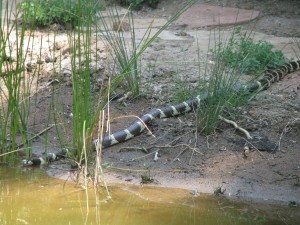
Coming down to the watering hole. With the AAUW Garden Tour coming up in three days (yikes!) and so much still to do, and of course working in the 80+ degree heat this week, I haven’t been doing much else. However the heat did bring out our annual visitor to the upper pond.
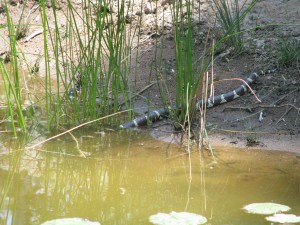
More than a drink... he's going in! He (or she) visits a couple of times a year, and seems to enjoy the new shape of the pond with its long shallow end.
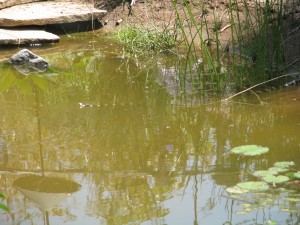
Swimming the channel. I wish he’d go after the bullfrog!
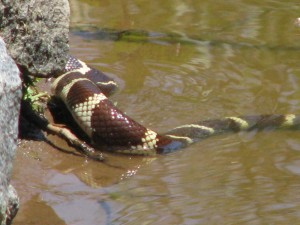
Beautiful bands. Siblings can be striped or banded. Kingsnakes are mild snakes that will eat other snakes, including rattlers. I’m glad to see him!
- Animals, Chickens, Compost, Gardening adventures, Permaculture and Edible Forest Gardening Adventures, Soil, Vegetables, Worms
Fifty Ways To Leave Your Compost

Its not fruit; its pre-compost! I have no idea how many years I’ve composted kitchen scraps. So many that when I see anyone dump veggie bits, egg yolk and shells, plate scrapings, old leftovers and even floor sweepings into the regular garbage it sets off all of my alarms. How can anyone waste all that good stuff? That is like throwing gold away! Its not dead stuff… its all living and ready to transform in to perfect soil, which shoots health into your plants! Most people say that they don’t have the time to compost, or they don’t want to turn a heap.
Well.
Here may not be fifty ways to compost easily, but certainly enough for ANYONE to keep their compostables out of the mainstream trash. And apologies to Paul Simon.
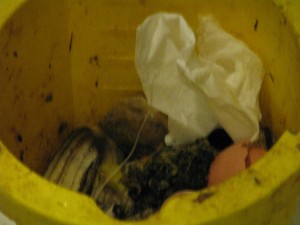
A blurry glimpse into my sink composting bucket. Egg shells, tea bags, banana peels, and tissues! 1. You Just slip out the back, Jack, with that little pail you have in or under your sink, into which you scrape everything compostable. They warn you about bones and meat because of animals digging through your heap to get to them, but if you bury your compost deeply, you won’t have that problem. I use a little bucket that they gave me for heaven-knows-what-reason at the hospital when I had my gall bladder out. It isn’t pretty, but it does the job. When I had both my children at home there was a lot more veggie peels to deal with, so in my kitchen I had a woven laundry basket, and inside I had two plastic liners, one for recycling and one for compost.

Big ol' basket, divided in half inside. One part recycling, the other compost. I only emptied it once a week. I didn’t like using so much plastic, but I’d put the plastic bag in the recycling. They sell all kinds of really nifty compost buckets now. Get one with a lid to keep those annoying little fruit flies from developing. Or if you have an open bucket like mine, just fill it partly with water so that the compost is submerged. It is easier to dump out that way and keeps cleaner, too. Especially if you’re going to…
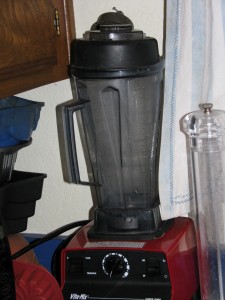
Is it a Vita-Mix, or is it a composting machine? Make a new plan, Stan, and instead of making a compost heap, you put all those scraps (barring big pits and nut shells) with water into a blender and whip it up. Then march outside and pour that brew around your plants! You can always kick a little dirt over it if its thick. This gives your plants a fantastic compost boost. Since it is undecayed pureed plant matter, you don’t want to bind up the nitrogen around seedlings or young plants, so pour it outside the drip line (how far the roots come out), or in an area you are preparing to plant in the future. This compost will decompose with days, depending on how warm the ground is (cold weather kills off or slows down microbes and wormies). If it is snowy winter where you are, then you might just freeze the stuff, in ice cube form or in paper cups. When the soil warms, plant those cubes! (Be sure to label them when in the freezer so no one thinks they are smoothie-pops!)

Freeze your blended compost, then empty the cubes into a bag and LABEL. You don’t need to be coy, Roy, but depending on your neighbors you may not want them to see you burying your compost. That’s right, you don’t have to make a heap, or blend it up. Just march outside with your bucket and a shovel or trowel, dig some small holes and bury it! The wormies will turn it into soil for you in weeks. Sometimes you’ll get surprises, like when a potato sprouts…. free veg! Here again for those who have frozen winters, you can pop the compost as is in a bag in the freezer. The only problem is freezer space. Just think, though, every bit you can save helps your garden!
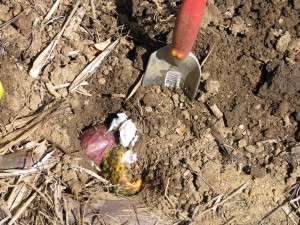
Dig it in! Just get yourself free from all your hangups about compost heaps and go buy a compost bin. I’ve a Rubbermaid bin for about twelve years. When my compost container is full I march it down, open the top, toss in the contents and away I go. When I pull weeds or thin the garden, I throw that in there too. Do I turn it? Heck, no! But if I wanted to I could very easily. The sides and two halves of the top fit together like enormous puzzle pieces, so I just need to take them all off, reassemble them right next to the heap, then pitchfork the compost back into it. The stuff that was on the top would now be on the bottom. Fresh compost can be shoveled out of a hole in the side on the bottom. Compost that is turned is not only matured faster, but is of a better quality and more broken down than that which isn’t turned. But as the bumperstickers say, compost happens! Stuff breaks down. Throw stuff into the top of the bin, and rake it out the bottom. Free your mind from compost regulations! Just go for it!

Throw it on! Compost happens! Hop on the bus, Gus, and become a real composter. You can build compost bins very cheaply. If you can nail things together so that they actually stay together (I can’t), you can build a three-section compost bin out of old pallets. There are lots of YouTube videos showing how. The best kind have removable slats in the front so that you can start low and gradually add to the front as the heap grows. Then when you want to turn it into the next bin, you may easily remove the slats for quick access. You can also just take a section of wire and make a cylinder out of it, then pitchfork in the weeds, grass, and throw in the kitchen trimmings. When its time to turn it, just undo the wire or slip it off, and set it up next to the pile again. Or have a line of wire cages. I have three, plus my bin. Do I turn them either? No. I keep throwing on excess weeds, and it keeps sinking down. Remember: compost happens!
You don’t need to discuss much with wormies because they can’t answer you: their little mouths are so full of your kitchen waste that they can’t talk! Make yourself a worm bin. Or buy one. You’ll need two dark plastic bins (one fits inside the other). Drill holes all through the lid for ventilation, and in just one of the bins drill some holes along the top of the sides, then drill tiny holes in the bottom for drainage. Fit the drilled bin inside the non-drilled bin. Put wads of newspaper, or paper from your paper shredder (unless you are saving it all to pack your mail-out Christmas gifts with instead of those nasty Styrofoam things) in the bin up to about half way. Lightly sprinkle with water. Throw a little soil in there, but not much for these kinds of worms. Find someone who has worms, or buy some red wigglers. You don’t want earthworms. Put these little guys gently into the bin. Take your compost and put it into one corner. Cover with a dampened sheet of newspaper and put the ventilated lid on the top. Keep the wormies from extreme temperatures. Some people keep a bin under their kitchen sink. Many school kids keep wormies as projects and for fun (baby wormies are white and wiggly!). As the wormies devour your compost they’ll leave behind castings, which look like sticky dirt. This is gold. If they had worm castings in Fort Knox instead of all that gold bullion our dollar would never fluctuate. What collects in the bottom bin is ‘worm tea’, which is just as valuable. Pour this stuff into your houseplants or directly on your plants. Commercial worm bins have several sections to hold more compost, are a little easier to manage and have a spigot for the worm tea. A perfect Mother’s Day gift! That or a compost bucket or bin!
Just drop off the key, Lee, with your housesitter when you go on vacation, and don’t forget to let her know to throw those kitchen scraps in with your chickens! Or goat! Or miniature pig! You don’t even need a heap when you have beaks! All those scraps are pure vitamins and minerals and chickens will not only devour them, but give you the best eggs you have ever tasted. Don’t forget to crush eggshells and give them right back to the chickens! They need that calcium to keep their eggs nice and hard. Chickens turn your compost into great eggs for you and great poo for the ground. Chicken manure can be used right away in your garden. Goaties will eat just about anything, as will piggies, so kitchen waste is perfect (slops).

Feed it to the chickens! And get yourself free from all that guilt that you shoulder when you throw food into the trash. Oh, and separate your recycling, too!
- Animals, Gardening adventures, Heirloom Plants, Permaculture and Edible Forest Gardening Adventures, Ponds, Reptiles and Amphibians, Soil, Vegetables
Earth Day at Finch Frolic
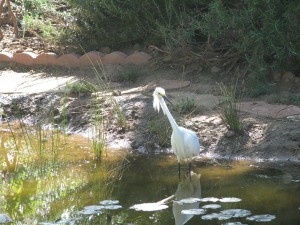
Snowy egret hunting. "Get the bullfrogs!" In celebration of Earth Day, I worked in the garden. You can stop laughing now. Yes, I know that I work in the garden nearly every day, and then spend time not volunteering or exercising, recovering from working in the garden. It was an overcast day, which beach-bound teenagers probably cursed, but I found perfect for working outside.

Roses in bloom everywhere. I had a visitor wishing me a Happy Earth Day.
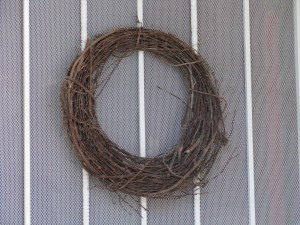
Do you notice anything about this wreath? This is an alligator lizard.
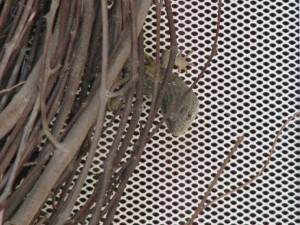
"Hello!" Hopefully he enjoyed the ride as I opened and closed the door several times to photograph him.
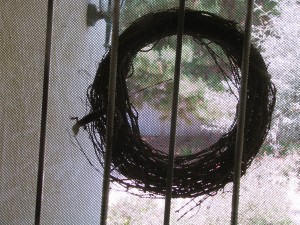
Alligator lizard from inside. Among other things today, I sifted compost. I had moved my compost bin, and this good compost was still on the ground from where it had been.
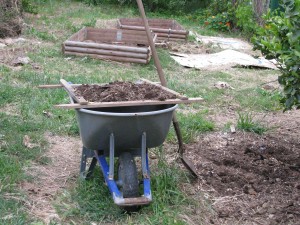
Sifting compost through a screen. I put it into a new raised (and wire-lined) bed.
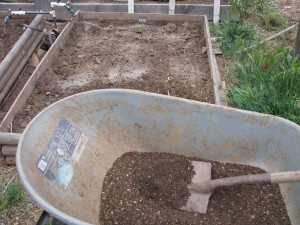
Adding sifted compost to the bed, which has been dusted with organic non-animal based fertilizer. Then I planted two rows of rice in it. Yes, rice. It is an heirloom variety from Baker Creek Organic Heirloom Seeds (http://rareseeds.com/rice-blue-bonnet.html), and it doesn’t need to stand in water to grow. Just something new and fun to try out.
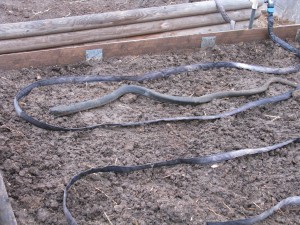
The rubber snake guards a freshly planted bed of rice. I’m also growing red seeded asparagus beans, the seeds of which were given to me by the woman who made the quail house. She also introduced me to Baker Creek, and for that I’m sincerely indebted. (http://rareseeds.com/red-seeded-asparagus-bean.html .)
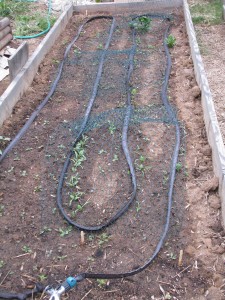
Spinach, carrots, edamame, sesame, Kentucky pole beans, endive and tomatoes are finally coming up. The other veggie beds are finally sprouting, now that the evenings have warmed up.
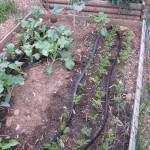
Collards and carrots, transplanted from another bed and doing well. 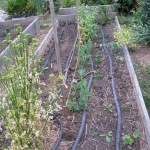
An incredible parsley setting seed, peas, parsnips, spinach, rhubarb, carrots and beans. 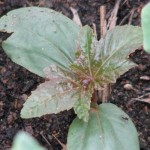
Castor bean seeds were in the mushroom compost, and I'm pulling them quickly. Here are a few views from other areas of the garden. Three weeds until the AAUW Garden Tour. Yikes!
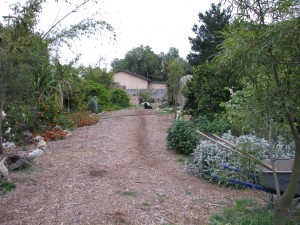
General Mischief waiting near the quail house for dinner. The hose connects to the 700 gallons of cootie water (compost tea) and is irrigating native plants. 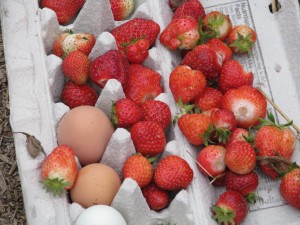
A happy harvest. Strawberries and eggs. I'm freezing the berries for later to make jam. 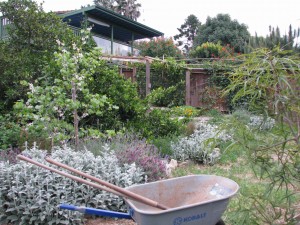
Lamb's Ear, whitebud, passionfruit and Bermuda grass 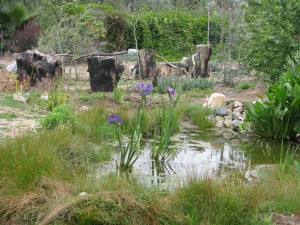
Stunning blue iris in the pond. 
Fringe tree in bloom. 
Iris -
They Followed Me Home, I Swear

Viola and Madge How many times do you go to the store for a couple of items and come back with a bag full? Too often for me. Yet, I persist in shopping. I went to the feed store for chicken scratch, and came back with new friends.

Madge's bad eye. She can find her food pretty well, though! These are two Rhode Island Red hens, about a year old, who had been victimized to the point of injury by sister hens. Too many birds in a small holding pen will do that, plus the whole pecking order thing. Most of us are familiar with that from living through middle school.

Viola's limp isn't this bad; she's just being dramatic for the camera. The larger bird is blind in the right eye. Her name is Madge (she looks like a Madge!). The smaller girl has a limpy leg, and her name is Viola (Twelfth Night). (Have you ever really looked at the word twelfth? I spelled it phonetically as twelph, and knew it was wrong but then had a hard time figuring the real spelling out after seeing it. Sorry… digression). Both are missing a lot of feathers in various places. These two were in a cage by themselves, and get along famously. The poor dears each laid an egg in the cardboard box in which they were transported.

A surprise in the box. Poor girls! I’ve put them in Emerson’s old run (oh, and his price has gone down to $15 and the warning sign is off his pen) until I can build the Hen House of my Dreams.

Temporary shelter in Emerson's cage. My other three girls, Lark, Chickpea and Miss Amelia are a happy trio and I don’t want to upset the apple cart, nor have the newbies subjected to pecking order again.

Lark (getting a bit fat) with Chickpea and Miss Ameila. I bought this fantastic chicken house some months ago, thinking it would be a warm spot for my three hens (wasn’t that a TV show? It should be one!) but they rejected it wholeheartedly. My girls are used to more space. I figured this pen would be good for some smaller breed. I’ve been looking for frizzle hens, but no one seems to have them. If I order from a hatchery it is straight run, which means unsexed chicks, and I don’t want to do the rooster thing again.

The Quail House. I’d like to establish California quail on the property, but since they are the state bird it is illegal to farm them here. Hatcheries in other states will send eggs, but at this moment I don’t have the time to care for eggs (and I’m too heavy to sit on them, although I do get broody a lot). I contacted Project Wildlife for rehabilitated quail for release, but they release within three miles of where the animals were found, which is an excellent policy. I’ve posted on Craigslist for both frizzle hens and Ca. quail, but no responses yet.
The quail that is commonly sold is the coturnix. These are Japanese quail. Because of their looks they are also called Egyptian quail, Pharaoh quail, and other names. They are less nervous than Bobwhite or button quail, they don’t fly up a lot so they don’t bang their heads on the top of the cage. They lay delightful brown speckled eggs. The feed store had a new shipment in, and they weren’t just selling pairs, so I bought three beautiful little girls, about six months old.

Saki. Very contempletive. My daughter did a quick and imaginative search for names and came up with a lot of really good ones. With a nod to the breed’s origin and alternative names, the dark brown one is called Saki, short for sakura which is Japanese cherry, rice wine, or also short for the Sakkara, which is an Egyptian city of temples. Covers all bases there. The mostly white one is called Benu, which is an Egyptian bird god you can read about here: http://www.thewhitegoddess.co.uk/articles/ancient_egypt/the_benu_bird.asp . The light brown one, incongruously, is named after Agatha Christie’s character Miss Felicity Lemon, most notably played by Pauline Moran in the Poirot television series. It was too good a name not to use, although rather long for such a handful of a bird.

Benu in the back, and Miss Felicity Lemon in the front. The quail don’t have much personality as yet. Of course, they had been raised crammed in cages with many other birds, shipped through the mail service, then moved to another cage with many other birds. They had arrived at the store on Sunday. These three are settling in slowly, enjoying the personal space and the tall weeds that have grown inside the coop (it is bottomless). After all the strange sounds and smells become commonplace, they’re personalities will emerge. They don’t scare or fly when approached, but hunker down in a fatalistic “this is my last moment on earth” kind of way. Already they are showing more hope in small ways as they react to my voice. I put them upstairs in the coop last night, but they were down again this morning. Their cage has handles so it can be moved when they’ve thoroughly manured that area. (There, I’ve said the ‘m’ word again!).

The RIR's eggs are on the left. Americauna and Silver Wyondotte on right. So more beaks to feed. At least I’m staying away from the Fallbrook Animal Sanctuary, at least for awhile. General Mischief and Sophie are too old for a new dog, and I certainly don’t need any more cats.
Of course, the llamas at the feeds store, and those really cute guinea pigs, could really use a home….
